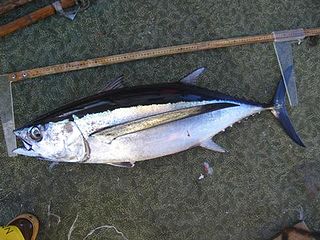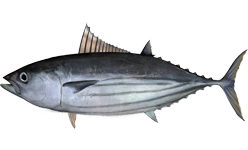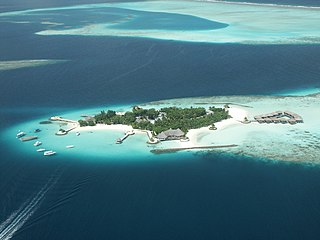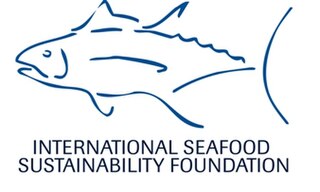
A tuna is a saltwater fish that belongs to the tribe Thunnini, a subgrouping of the Scombridae (mackerel) family. The Thunnini comprise 15 species across five genera, the sizes of which vary greatly, ranging from the bullet tuna up to the Atlantic bluefin tuna, which averages 2 m (6.6 ft) and is believed to live up to 50 years.

The albacore, known also as the longfin tuna, is a species of tuna of the order Scombriformes. It is found in temperate and tropical waters across the globe in the epipelagic and mesopelagic zones. There are six distinct stocks known globally in the Atlantic, Pacific, and Indian oceans, as well as the Mediterranean Sea. The albacore has an elongate, fusiform body with a conical snout, large eyes, and remarkably long pectoral fins. Its body is a deep blue dorsally and shades of silvery white ventrally. Individuals can reach up to 1.4 m in length.

The yellowfin tuna is a species of tuna found in pelagic waters of tropical and subtropical oceans worldwide.

Gillnetting is a fishing method that uses gillnets: vertical panels of netting that hang from a line with regularly spaced floaters that hold the line on the surface of the water. The floats are sometimes called "corks" and the line with corks is generally referred to as a "cork line." The line along the bottom of the panels is generally weighted. Traditionally this line has been weighted with lead and may be referred to as "lead line." A gillnet is normally set in a straight line. Gillnets can be characterized by mesh size, as well as colour and type of filament from which they are made. Fish may be caught by gillnets in three ways:
- Wedged – held by the mesh around the body.
- Gilled – held by mesh slipping behind the opercula.
- Tangled – held by teeth, spines, maxillaries, or other protrusions without the body penetrating the mesh.

Seine fishing is a method of fishing that employs a surrounding net, called a seine, that hangs vertically in the water with its bottom edge held down by weights and its top edge buoyed by floats. Seine nets can be deployed from the shore as a beach seine, or from a boat.

The skipjack tuna is a perciform fish in the tuna family, Scombridae, and is the only member of the genus Katsuwonus. It is also known as katsuo, arctic bonito, mushmouth, oceanic bonito, striped tuna or victor fish. It grows up to 1 m (3 ft) in length. It is a cosmopolitan pelagic fish found in tropical and warm-temperate waters. It is a very important species for fisheries.

Pelagic fish live in the pelagic zone of ocean or lake waters—being neither close to the bottom nor near the shore—in contrast with demersal fish that live on or near the bottom, and reef fish that are associated with coral reefs.

Drift netting is a fishing technique where nets, called drift nets, hang vertically in the water column without being anchored to the bottom. The nets are kept vertical in the water by floats attached to a rope along the top of the net and weights attached to another rope along the bottom of the net. Drift nets generally rely on the entanglement properties of loosely affixed netting. Folds of loose netting, much like a window drapery, snag on a fish's tail and fins and wrap the fish up in loose netting as it struggles to escape. However, the nets can also function as gill nets if fish are captured when their gills get stuck in the net. The size of the mesh varies depending on the fish being targeted. These nets usually target schools of pelagic fish.
A payao is a traditional fish aggregating device from the Philippines. Payaos are traditionally floating rafts of bamboo anchored to the seafloor, with submerged weighted palm fronds beneath it. They were harvested using handline fishing, surface trolling, or small-scale purse seining. Modern steel payaos use fish lights and fish location sonar to increase yields. While payao fishing is sustainable on a small scale, the large scale, modern applications have been linked to adverse impacts on fish stocks. Payaos have been introduced to fishermen in Vietnam, Thailand, and various countries in Oceania.

The blackfin tuna is a species of tuna in the family Scombridae. It is occasionally referred to as the Bermuda tuna, blackfinned albacore, or deep bodied tunny. They are the smallest tuna species in the genus Thunnus, generally growing to a maximum of 100 cm (39 in) in length and weighing 21 kg (46 lb).

Fishing techniques are methods for catching fish. The term may also be applied to methods for catching other aquatic animals such as molluscs and edible marine invertebrates.

The rainbow runner, also known as the rainbow yellowtail, Spanish jack and Hawaiian salmon, is a common species of pelagic marine fish of the jack family, Carangidae. The species is widespread throughout the tropical and subtropical waters of the world, inhabiting both coastal and offshore areas. The species is the only member of the genus Elagatis, which was created 15 years after its initial description, and is closely related to the amberjacks. The rainbow runner is easily distinguished by its body shape, and the brilliant colouration which gives the fish its name. It is a fast-swimming predator, taking small fish, cephalopods, and a wide variety of planktonic crustaceans. The species reaches sexual maturity around 60 cm (24 in), and spawning takes place at different times, with some populations spawning year round, while others only spawn at certain times of the year. The species is a well known game fish, taken by a variety of fishing methods, and is a well-regarded table fish. Large numbers of the species are taken as bycatch in tuna- and shark-fishing operations and marketed.
This page is a list of fishing topics.
This is a glossary of terms used in fisheries, fisheries management and fisheries science.
Land-based game fishing is a form of big-game sport fishing in which anglers attempt to catch oceanic game fish from shore rather than from ocean-going boats. The locations for such activities are generally rock platforms, though wharfs, jetties and beaches are also common. Some species such as sharks can be targeted in shallow littoral water, however most other species prefer deeper pelagic water, and this limits the areas where these types can be fished from the shore. Tackle used is usually comparable to that used on boats, but some differences are necessary, such as changes in rod length. Different tackle is used according to location and species targeted.

The fishing industry in the Maldives is the island's second main industry. According to national tradition in the words of former President Maumoon Abdul Gayoom, "Fishing is the lifeblood of our nation, it is inborn. From the soil on which we live, to the sea around us, it remains an integral part of our existence. Fishing, and our country and its people, [are] one and shall remain inseparable forever." The Maldives has an abundance of aquatic life and species of fish. Common are tuna, groupers, dolphin fish, barracuda, rainbow runner, trevally and squirrelfish and many more. Aside from being of essential importance to the economy, fishing is also a popular recreational activity in the Maldives, not only among locals but by tourists. The islands have numerous fishing resorts which cater for these activities.

International Seafood Sustainability Foundation (ISSF) was formed in 2009 as a global, non-profit partnership among the tuna industry, scientists and World Wide Fund for Nature. The multistakeholder group states its mission is "to undertake science-based initiatives for the long-term conservation and sustainable use of tuna stocks, reducing bycatch and promoting ecosystem health". Regional Fisheries Management Organizations (RFMOs) are primarily responsible for managing the world's tuna stocks—skipjack, yellowfin and albacore tuna, the species most commonly processed for canned and shelf-stable tuna products, but their parliamentary procedures too often allow the short-term economic and political interests of nations to prevent sustainable measures from being adopted. ISSF works to ensure that effective international management practices are in place to maintain the health of all the tuna stocks.
The Republic of the Marshall Islands has a commercial fishery that targets bigeye and yellowfin tuna using pelagic longline fishing gear. There were 55 longline vessels licensed to fish in the Republic of the Marshall Islands Exclusive Economic Zone (EEZ) in 2011, of which 4 were Marshall Islands-flagged and 51 were foreign-licensed vessels, including 22 Chinese-flagged, 16 Japanese-flagged, 11 Federated States of Micronesia-flagged, and 2 Taiwan-flagged. The Japanese-flagged longliners land their catch in Japan; the other 39 vessels were domestically-based. In 2011, the Marshall Islands longline fleet had reported landings of principal market species of 259 mt of bigeye tuna, 99 mt of yellowfin tuna, 37 mt of blue marlin, 7 mt of black marlin, 4 mt of albacore tuna, and 3 mt of broadbill swordfish. Fresh chilled bigeye and yellowfin tuna is exported primarily to markets in the U.S., China and Canada, and frozen tuna and incidental market species are exported to China and marketed locally.

Canthidermis maculata, also known as rough triggerfish or spotted oceanic triggerfish, is a species of triggerfish native to the tropical and subtropical oceans worldwide. Unlike most triggerfish, they are mostly pelagic.

US FWS Charles H. Gilbert was an American fisheries science research vessel in commission from 1952 to 1970 in the fleet of the United States Department of the Interior's Fish and Wildlife Service and from 1970 to 1973 in the fleet of the National Oceanic Atmospheric Administration as NOAAS Charles H. Gilbert. She was among the first U.S. fisheries science vessels to explore the central Pacific Ocean in search of commercially valuable populations of fish.


















